
As per the findings of an NREGA tracker launched by the People’s Action for Employment Guarantee (PAEG) the lockdown saw a record spike in jobs under Mahatma Gandhi National Rural Employment Guarantee Act (MGNREGA).
The tracker points that over 7.62 crore households had received jobs under the scheme between April and June 2020, during the Covid-19 induced lockdown. Despite the record job availability under NREGA since April 2020, about 22% (1.7 crores) of applicants hadn’t got work as of 7 July 2020.
Coalition to strengthen NREGA implementation
PAEG is comprised of a group of activists, academics, and other civil society members who came together in 2004 to advocate for the NREGA scheme that offers 100 days of guaranteed work per year to rural households.
The NREGA tracker provides broad statistics to assess the performance of the scheme on parameters such as the number of households that have completed 100 days of work, the number of households nearing completion of 100 days of work, amount of funds left with states, a comparison between work demanded and employment provided. The tracker also provides two graphs monitoring the NREGA performance annually. It shows the inflation-adjusted budget over the years and the pending liabilities as a proportion of the annual budget.
The data used by the tracker is sourced from the NREGA Management Information System (MIS) of the Ministry of Rural Development, Government of India’s nodal ministry for NREGA.
What does the tracker show?
The sudden influx of millions of migrants into the rural hinterland and the resultant unemployment crisis after the Covid-19 induced lockdown made NREGA more crucial than ever. According to official data, 67 lakh migrants have returned home during this period. As per the tracker, 35 lakh new job cards have been issued since April 2020, indicating a spurt in demand for NREGA employment.
April 2020 recorded the lowest employment in several years. However, data indicates that 3.22 crore households have been employed under NREGA in June 2020, 50% more compared to last year. With unlocking, a record number of households have been employed under NREGA in the first quarter of the financial year.
As per the tracker, 2.26 lakh households have completed 100 days of work already, underscoring the importance of NREGA. The scale of NREGA employment is much higher in states like Andhra Pradesh (1.04 lakh), Telangana (72,000) and Chhattisgarh (57,000). The numbers of households that have already completed 100 days in this financial year are shown in the table below.


As per the tracker, there is a 22% unmet demand of work (1.7 crore people), and states like Uttar Pradesh, Bihar, and Madhya Pradesh, have the highest share of dejected applicants. The share of applicants who have applied for a job under NREGA since April in Uttar Pradesh (35 lakh persons;30%) who have demanded work are yet to be provided work, while in Bihar the unmet demand is about 10 lakh persons (24%).
The figures would be much higher if there is no demand suppression at the source. These states also have less than 10% of their allocated funds left. The tracker also points to the fact that local officials tend to limit the demand for work application that are registered to avoid payment of unemployment allowance.

The tracker shows a negative balance in funds owing to the record demand in the first quarter of 2020-21. Drying up of funds was noted in states like Tamil Nadu and Odisha, where the governments have been forced to overdraw wage allocations to the tune of Rs 1,391.61 crore and Rs 91.38 crore, respectively, the tracker points.
The additional allocation of 1 lakh crore for NREGA this year announced by the centre is inadequate to deal with the economic impact of the Covid-19 crisis.
NREGA still constitutes only 0.47% of GDP and adjusting for inflation, the allocation each year from 2014 has been lower than that of 2010-11. The allocation has been dwindling around 0.3% of GDP since 2014. It has never crossed the high of 0.6% of GDP touched in 2010. World Bank Economists, Murgai and Ravallion (2005), have argued that 1.7% of the GDP needs to be allocated for NREGA for it to run robustly.
Of this, an average of 17% is spent to clear pending liabilities. For the year 2020-21, 10% of the budget was used to clear pending liabilities after revised allocation. With the 2020-21 budget for NREGA being the highest ever, the proportion that will be spent to clear pending payments is lower than in previous years. PAEG and various other groups have been advocating for an increase in NREGA's budget for years.
Around Rs 43,000 crore or 43% of the NREGA budget for 2020-21 has been spent already in the first quarter. Even with the highest ever allocation for NREGA this year, the record demand and employment provision in the first quarter means that funds are drying up fast.
While Odisha is a good example of a state that has leveraged NREGA to respond to the distress of returning migrants and the unemployment crisis, it already has a negative balance. States like Bihar, Madhya Pradesh, Uttar Pradesh which have amongst the highest unmet work demand also have less than 10% of their allocated funds left. This will have two potential consequences on the ground. Either local officials will stop registering more demand and opening work or work will be provided but payment delays will accumulate.
There is a need to address the high demand now as well in the near future and increase allocations as per the Act in order to deal with the deficit in work demanded and employment provided.
There is a need to improve the accountability of NREGA and PAEG's tracker helps provoke discussion and peoples' monitoring to strengthen the implementation of NREGA.